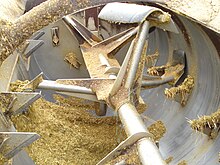Total mixed ration
The total mixed ration is a feeding system in the livestock industry in which all feed components are mixed in a feed mixture. Other names are full-TMR , total mixed ration , total mixed ration or short TMR (transferred from the English. Total mixed ration ) In everyday language, the so-assembled feed mixture is sometimes even referred to as TMR. In contrast to this, there is the partial mixed ration (partial TMR ), in which the individual animal feed is allocated . A mixer wagon is usually used for both methods .
Advantage of a full TMR
By feeding the mixed feed, the dry matter content and energy content of the feed ration consumed by the animal can be increased, so that the amount of milk can be increased.
Group formation
In order to approximate animal-specific feeding, the cows are divided into groups within a farm. In practice, the natural milk yield varies between 20 and 60 liters per day depending on the individual animal, breed and the time since the calf was born. Accordingly, a full TMR can only be set correctly with several animal groups, so that some animals do not receive too much energy and protein, and others too little. An average European farm has 5 groups of cows. As a rule, there are then two rations for dry cows, one for the 2 weeks after the birth of the calf, one for high-yielding cows and one for old-milking, obese cows.
disadvantage
- When changing groups, there is a drop in performance.
- The rumen microbial flora must adapt to other basic feed such as grass silage. This process can take up to 4 weeks.
- Part of the reason for underperformance is the stress of integrating into a new group of animals.
- High-performance animals are also not adequately fed and consume more of their body substance than would be the case with a partial mixed ration.
- Breed-related differences can hardly be dealt with in TMR feeding.
- Mixing several rations a day takes time and is more error-prone.
- The stable buildings often do not allow the group sizes to vary, so that compromises inevitably arise there.
- The groups must also be maintained during work such as milking or grazing. Here, too, there is quickly a higher workload or compromises.
- Concentrated feed in grams per liter of milk is around 20% higher at TMR farms. This leads to additional costs for TMR of around 1.5 cents per liter of milk.
- Barriers in the barn, depending on the barn system, lead to dead ends, which no longer offer low-ranking animals any escape.
alternative
The upgraded mixed ration (also partial mixed ration ; transferred from the English partly mixed ration , PMR for short) is a feeding system that combines TMR as a flat-rate basic feed mixture with a small amount of concentrated feed ( separate concentrate feeding , SCF). Another concentrate is a concentrate feed station allocated to individual animals. The concentrate station is increasingly being combined with milking technology. A milking robot doses the amount of concentrate individually according to parameters such as amount of milk, day of lactation and body condition. A basic ration for all cows can be presented at the trough. The concentrate station can then use the animal identification to output a correspondingly correct supplement type of concentrate.
Individual evidence
- ↑ Horst Eichhorn (editor), Landtechnik, 7th edition, Ulmer, Stuttgart, 1952, 1999, ISBN 3-8001-1086-5 , p. 468 ff.
- ↑ University of Hohenheim Ratje ( Memento of the original dated February 3, 2016 in the Internet Archive ) Info: The archive link was inserted automatically and has not yet been checked. Please check the original and archive link according to the instructions and then remove this notice.
- ↑ University of Hohenheim, page 17 ( Memento of the original dated February 3, 2016 in the Internet Archive ) Info: The archive link was inserted automatically and has not yet been checked. Please check the original and archive link according to the instructions and then remove this notice.
- ↑ DLR Westerwald-Osteifel ( Memento of the original from February 3, 2016 in the Internet Archive ) Info: The archive link was inserted automatically and has not yet been checked. Please check the original and archive link according to the instructions and then remove this notice.
- ↑ University of Bonn, dead ends in the stable
- ↑ Chamber of Agriculture North Rhine-Westphalia, risk of injury to cows from sheds and dead ends
- ↑ Feeding systems and strategies. (No longer available online.) In: Dairy knowledge. DeLaval , archived from the original on October 24, 2006 ; Retrieved October 21, 2010 . Info: The archive link was inserted automatically and has not yet been checked. Please check the original and archive link according to the instructions and then remove this notice.
literature
- J. Thomsen: TMR [Total Mixing Ration]: a new magic formula for feeding? in: Top agrar: the magazine for modern agriculture, SR issue, 1993
- Qendrim Zebeli: Influence of the particle length of total mixed rations TMR on the digestive stratification and digestive processes in the rumen of high-performing dairy cows , Diss. Hohenheim Univ., Shaker Verlag , Aachen 2006
- Ulrich Westrup: Company report on TMR feeding. Make full use of your genetic capabilities! (PDF; 391 kB) In: Großtierpraxis 7/2000. VAV publishing house for agricultural sciences and veterinary medicine. ISSN 1616-2315 . Pp. 26-34.
- F. Nydegger, 2004: Dairy cattle feeding - submit conventional ration or total mixed ration (TMR)?
